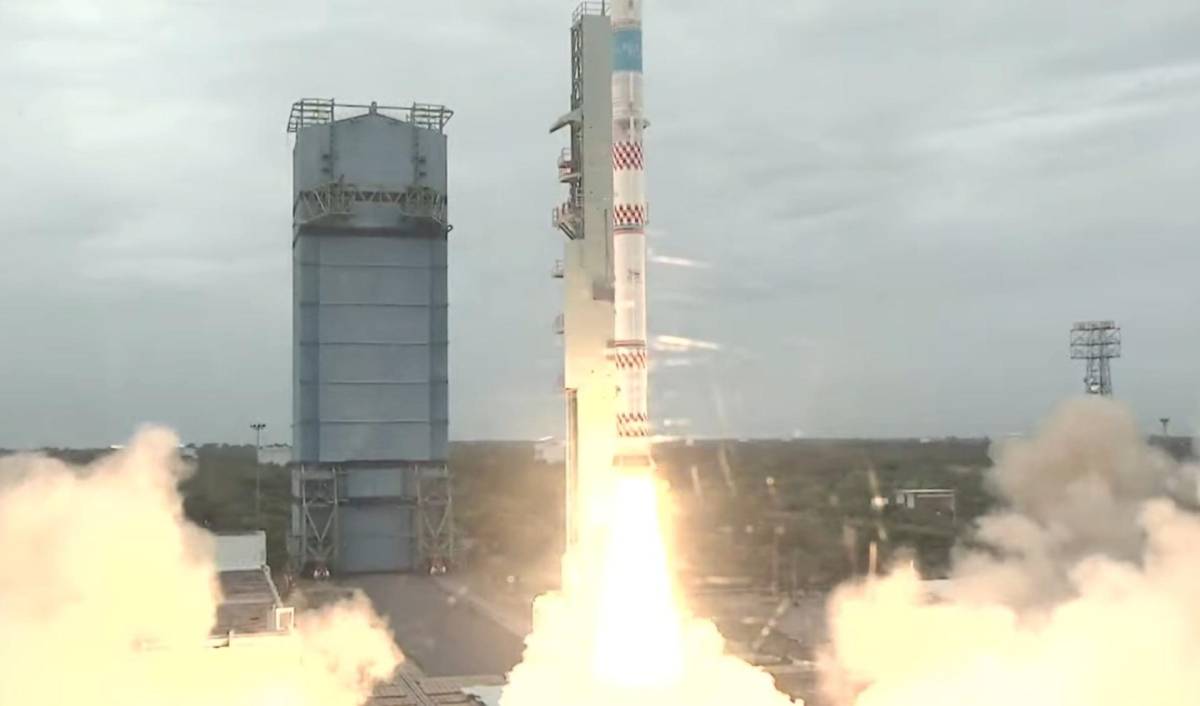According to the ISRO, the SSLV is a ready to transfer rocket with modular and unified systems with standard interfaces for production by the industry…reports Asian Lite News
India’s brand new rocket Small Satellite Launch Vehicle (SSLV-D1) on Sunday morning lifted off with an earth observation satellite-02 (EOS-02) formerly known as Microsatellite-2 weighing about 145 kg.
Piggybacking on that was the eight kg AZAADISAT built by 750 students of government schools facilitated by SpaceKidz India.
At about 9.18 a.m. the 34 metre tall and 120 ton rocket broke free of the first launch pad and started its maiden upward one way journey carrying the two satellites.
The rocket with a thick orange flame at its tail slowly gathered speed and went up and up.
Just over 12 minutes into its flight, the SSLV-D1 will put into orbit the EOS-2 satellite and a few seconds later the AZAADSAT will be orbited.
According to the ISRO, the SSLV is a ready to transfer rocket with modular and unified systems with standard interfaces for production by the industry.
The SSLV design drivers are low cost, low turnaround time, flexibility in accommodating multiple satellites, launch-on-demand feasibility, minimal launch infrastructure requirements and others, ISRO said.
The commercial arm of ISRO, NewSpace India Ltd plans to transfer the SSLV technology for production in the private sector.
The Indian space agency said the EOS-02 satellite is an experimental optical imaging satellite with high spatial resolution. The objective is to realise and fly an experimental imaging satellite with short turnaround time and showcase launch on demand capability.
The new technologies realised for the Microsat series of spacecrafts include payloads with a common fore optics and metallic primary mirror realised with the limited mass and volume of Microsat Bus, ISRO said.
With the new launch vehicle included in its product lineup, ISRO will have three rockets — Polar Satellite Launch Vehicle (PSLV) and its variants (cost about Rs 200 crore), Geosynchronous Satellite Launch Vehicle (GSLV-MkII cost about Rs 272 crore and Mk III Rs 434 crore) and SSLV (Development cost of three rockets about Rs 56 crore each) and production cost may go down later.
According to SpaceKidz India, the significance of this project is that it has been conceptualised as a tribute to mark the 75th anniversary of Independence.
“From 75 government schools for girls across India, we have selected 10 students to give this opportunity. The selected students are predominantly from Classes 8-12. This is a first of its kind Space mission with an ‘All women concept’ to promote women in STEM as this year’s UN theme is ‘Women in Space’,” SpaceKidz India said.

Niti Aayog has partnered for this project to bring this opportunity to students of the government girl schools across India.
Hexaware is supporting by funding the project.
ISRO taking steps to protect India’s space assets
The Indian space agency is taking necessary measures to protect the country’s space assets from intentional and accidental close approaches by other space objects, said Union Minister of State for Science and Technology Dr. Jitendra Singh.
He also said around 60 startups have registered with the Indian Space Research Organisation (ISRO), quite a few of them are dealing with projects related to space debris management.
The other startup proposals vary from nano-satellite, launch vehicle, ground systems, research and others, Singh said after inaugurating ISRO System for Safe & Sustainable Operation (IS4OM) at ISRO Control Centre, in Bengaluru on Monday.
According to Singh, Space Situational Awareness activities have many strategic implications such as identifying and monitoring other operational spacecraft with close approaches, having overpass over Indian region, intentional manoeuvres with suspicious motives and re-entry within the Indian region.
The IS4OM facility will enable India in achieving its Space Situational Awareness goals by providing a comprehensive and timely information of the space environment to users.
This multi-domain awareness platform will bring prompt, accurate and efficient information on on-orbit collision, fragmentation, atmospheric re-entry risk, space based strategic information, hazardous asteroids and space weather forecast, Singh said.
According to S. Somanath, Secretary, Department of Space, infrastructure for Space Weather monitoring and forecast plays a critical role in protecting space based as well as ground-based infrastructure from critical Solar activities.
On an equal footing, detection and prevention of asteroid impacts are essential for human welfare. Vision of IS40M towards space weather services and planetary defence initiatives are also to be important areas of SSA, he said.
